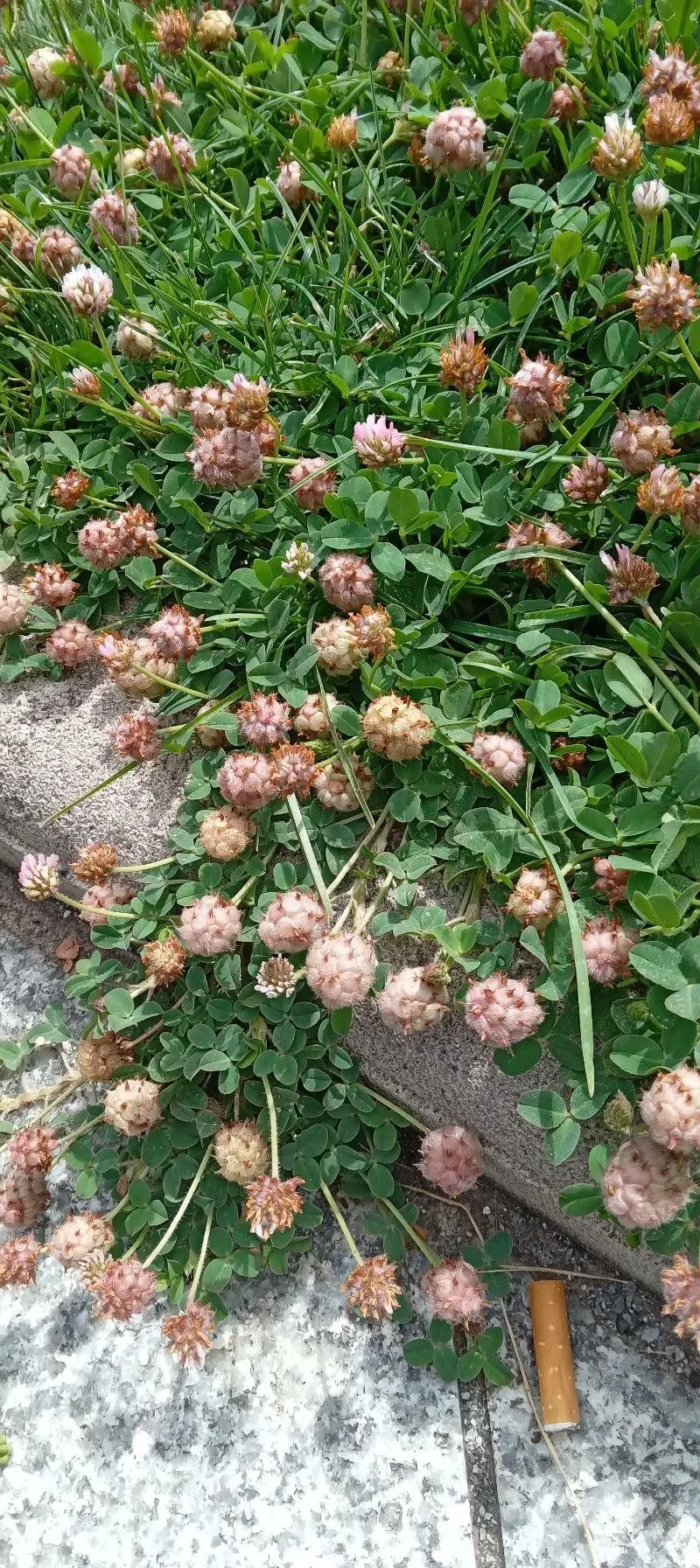
Author: L.
Bibliography: Sp. Pl.: 772 (1753)
Year: 1753
Status: accepted
Rank: species
Genus: Trifolium
Vegetable: False
Observations: Europe to Xinjiang, Macaronesia, N. Africa to NW. India
Strawberry clover, scientifically known as Trifolium fragiferum, is a fascinating member of the Fabaceae family. This perennial herb has garnered attention not only for its distinctive name and appearance but also for its wide geographical distribution and ecological adaptability.
First described by the renowned botanist Carl Linnaeus in 1753 within his seminal work “Species Plantarum,” Strawberry clover is noted for its unique strawberry-like flower heads. These globular inflorescences, which turn a rosy hue as they mature, are a standout feature among clovers, lending both visual appeal and its charming common name.
Geographically, Trifolium fragiferum boasts a broad native range. It spans much of Europe and extends all the way to the reaches of Xinjiang. Furthermore, it is found in Macaronesia, a region encompassing the Azores, Madeira, and the Canary Islands, as well as stretching across Northern Africa to the northwestern parts of India. Such extensive distribution illustrates the plant’s remarkable versatility and ability to thrive in a diverse array of climates and habitats.
Ecologically, Strawberry clover plays a vital role in its ecosystems. As a member of the Fabaceae family, it contributes to soil health through nitrogen fixation—a crucial process where atmospheric nitrogen is converted into a form accessible to plants. This not only benefits the clover itself but also improves soil fertility, thereby supporting other plant species.
In addition to its ecological benefits, Trifolium fragiferum is valued for its resilience. It is particularly well-adapted to saline soils and wetland areas, making it an excellent species for reclamation projects and erosion control. Its hardy nature also means it can withstand periodic flooding, making it a robust plant for challenging environments.
In summary, Strawberry clover (Trifolium fragiferum) is a notable species both for its distinctive strawberry-like flower heads and its broad ecological range from Europe to northwestern India. With its beneficial role in nitrogen fixation and its adaptability to various environmental conditions, this plant stands as a valuable asset to both natural habitats and agricultural practices.
Deu: erdbeer-klee, erdbeerklee
Dan: jordbær-kløver
Nor: jordbærkløver
Eng: strawberry clover, strawberryhead clover
Nld: aardbeiklaver
Nno: jordbærkløver
Nob: jordbærkløver
Swe: rakkoapila, smultronklöver, blåsklöver
Fin: rakkoapila
Ita: trifoglio fragifero
Fra: trèfle fraise, trèfle fraisier, trèfle porte-fraise
Cat: trèvol maduixer
Spa: trébol fresero
Lav: zemenu abolinš
Cym: meillionen fefusaidd, meillionen pen-mefusaidd
En: Strawberry clover, Strawberry-Head Clover, Strawberryhead clover, Strawberry-headed Clover, Erdbeer Klee, Strawberry Trefoil
Af: Aarbei klawer
Ar: قداب (قَدَاب)، جدوب (جَدّوب), قرط (قُرط)، قدب (قَدْب)، قرض (قَرَض), نفل فراولي
Az: Boşmeyvə yonca
Be: Канюшына сунічная
Ca: Trèvol maduixer
Zh: Cao mei che zhou cao, 草莓车轴草
Cs: Jetel jahodnatý
Da: Jordbær-Kløver
Nl: Aardbeiklaver
Et: Randristik
Fi: Rakkoapila
Fr: Trèfle fraise, Trèfle fraisier, Trèfle porte-fraise, Trèfle porte-fraises, Trèfle-fraise
De: Erdbeerklee, Erdbeer-Klee
He: תלתן הביצות
Is: Strandsmári
It: Trifoglio fragifero, Trifoglio a fragola
Ja: Tsumekusa-damashi
Lv: Zemenu abolinš
Mk: Јагодеста детелина
No: Jordbærkløver
Nb: Jordbærkløver
Nn: Jordbærkløver
Fa: شبدر توتفرنگی
Pl: Koniczyna rozdęta
Ru: Клевер земляничный
Es: Trébol fresero, Fresa de burro, Trébol fresa
Sv: Smultronklöver, Rakkoapila, Blåsklöver
Uk: Конюшина суницеподібна
Cy: Meillionen fefusaidd, Meillionen Pen-Mefusaidd
© copyright of the Board of Trustees of the Royal Botanic Gardens, Kew.
© copyright of the Board of Trustees of the Royal Botanic Gardens, Kew.
© copyright of the Board of Trustees of the Royal Botanic Gardens, Kew.
Taken Jul 29, 2022 by Fabrice Rubio (cc-by-sa)
Taken Aug 19, 2022 by Fabrice Rubio (cc-by-sa)
Taken Jul 20, 2017 by Yoan MARTIN (cc-by-sa)
Taken Jul 29, 2022 by Fabrice Rubio (cc-by-sa)
Taken Aug 25, 2022 by Tristan Jaton-Maria (cc-by-sa)
Taken Jul 8, 2022 by Daniel Bourget (cc-by-sa)
Taken Jul 29, 2022 by Fabrice Rubio (cc-by-sa)
Taken Jul 31, 2012 by Tela Botanica − Emmanuel STRATMAINS (cc-by-sa)
Taken Jun 16, 2021 by Серёга Муравицкий (cc-by-sa)
Taken Aug 25, 2022 by Tristan Jaton-Maria (cc-by-sa)
Taken Jul 29, 2022 by Fabrice Rubio (cc-by-sa)
Taken Jul 20, 2017 by Yoan MARTIN (cc-by-sa)
Taken Aug 25, 2022 by Tristan Jaton-Maria (cc-by-sa)
Taken Aug 25, 2022 by Tristan Jaton-Maria (cc-by-sa)
Taken Jul 29, 2022 by Fabrice Rubio (cc-by-sa)
Taken Jul 20, 2017 by Yoan MARTIN (cc-by-sa)
Taken Jul 27, 2022 by Mary_T (cc-by-sa)
Taken Jul 24, 2019 by César Gonzalez (cc-by-sa)
Taken Jul 29, 2022 by Fabrice Rubio (cc-by-sa)
Taken Jun 19, 2018 by Mehmet Basbag (cc-by-sa)
Taken Jun 30, 2019 by Patrick Liouville (cc-by-sa)
Taken Mar 21, 2013 by EOL − Zoya Akulova (cc-by-nc)
Taken Sep 6, 2015 by Tela Botanica − Yoan MARTIN (cc-by-sa)
Taken Jul 20, 2017 by Yoan MARTIN (cc-by-sa)
Taken Jul 20, 2017 by Yoan MARTIN (cc-by-sa)
Taken Jul 15, 2003 by Photoflora – Jean-Luc TASSET (©)
Taken Aug 15, 2017 by Photoflora – Benoit BOCK (©)
Taken May 31, 1884 by Tela Botanica − Herbier PONTARLIER-MARICHAL (cc-by-sa)
Taken May 31, 1853 by Tela Botanica − Herbier PONTARLIER-MARICHAL (cc-by-sa)
Taken Jan 1, 1970 by Photoflora – L’Abbé COSTE (©)
Growth form: Stoloniferous
Growth habit: Forb/herb
Growth rate: Moderate
Ph maximum: 8.4
Ph minimum: 6.5
Light: 7
Atmospheric humidity: 8
Bloom months: [‘jun’, ‘jul’, ‘aug’, ‘sep’]
Soil nutriments: 7
Soil salinity: 3
Family: Myrtaceae Author: (F.Muell.) K.D.Hill & L.A.S.Johnson Bibliography: Telopea 6: 402 (1995) Year: 1995 Status:…
Family: Rubiaceae Author: Pierre ex A.Froehner Bibliography: Notizbl. Bot. Gart. Berlin-Dahlem 1: 237 (1897) Year:…
Family: Sapindaceae Author: Koidz. Bibliography: J. Coll. Sci. Imp. Univ. Tokyo 32(1): 38 (1911) Year:…
Family: Asteraceae Author: A.Gray Bibliography: Pacif. Railr. Rep.: 107 (1857) Year: 1857 Status: accepted Rank:…
Family: Fabaceae Author: Medik. Bibliography: Vorles. Churpfälz. Phys.-Ökon. Ges. 2: 398 (1787) Year: 1787 Status:…
Family: Aspleniaceae Author: (Cav.) Alston Bibliography: Bull. Misc. Inform. Kew 1932: 309 (1932) Year: 1932…